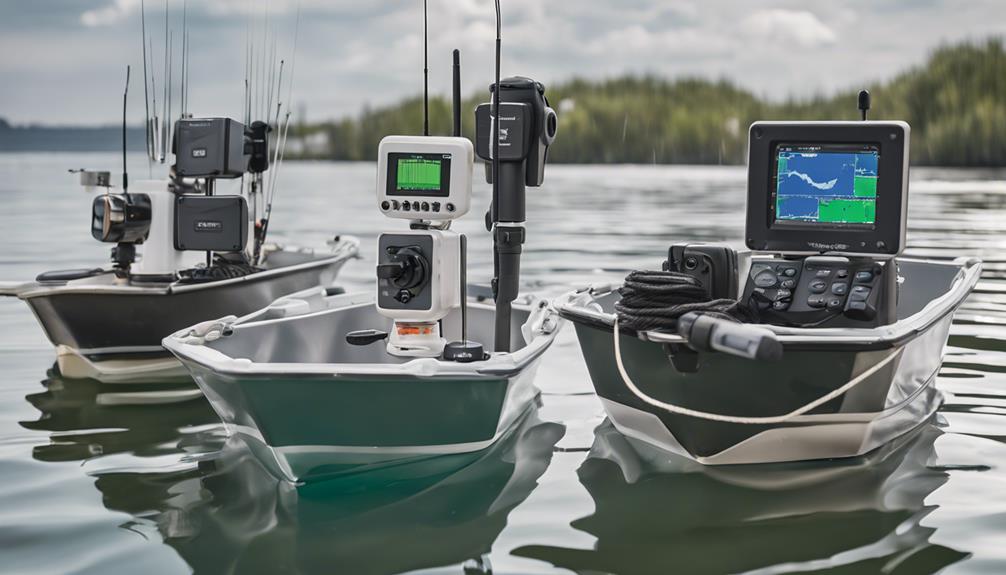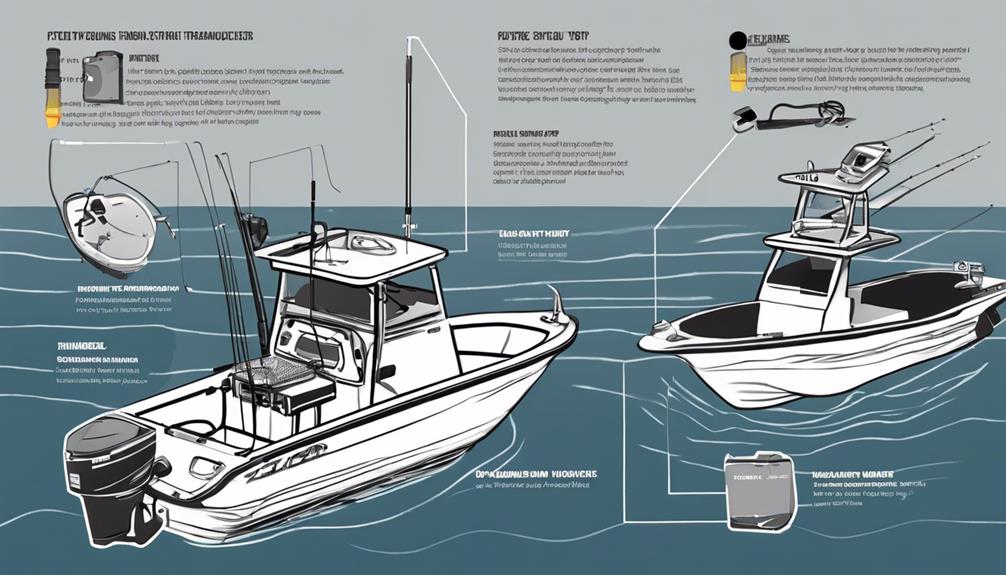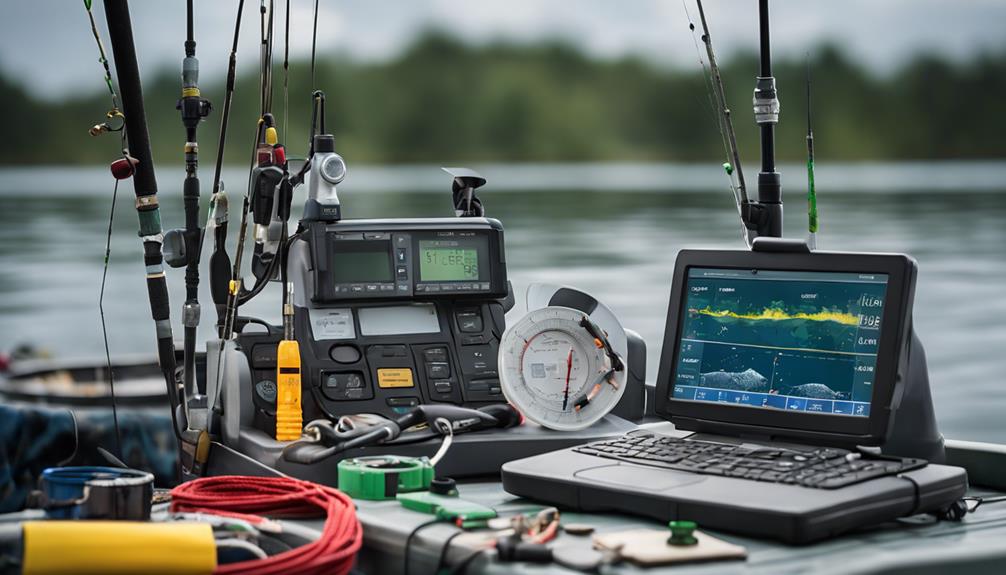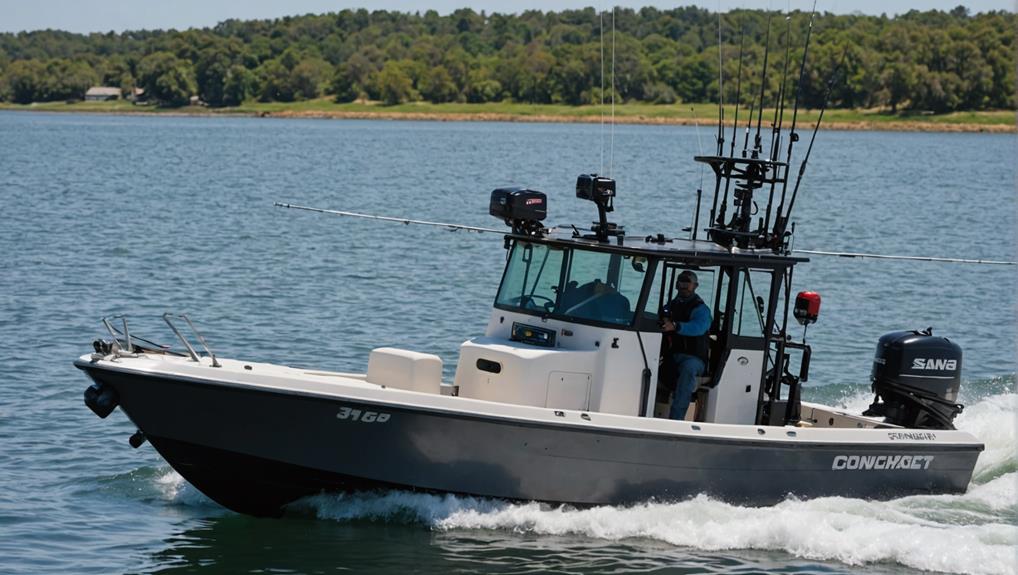You'll want a water depth sensor with advanced features like CHIRP sonar technology and high-speed accuracy when it comes to choosing the top models for your fishing boat. Look for sensors that can detect water depths up to 600 feet and provide real-time data and analysis to help you identify ideal fishing conditions. Some models also offer side imaging, 3D sonar, and GPS capabilities to enhance your fishing experience. Consider factors like transducer type and mount, frequency and power, screen resolution, and depth and speed capabilities to find the right sensor for your needs. Exploring the options further will reveal more about the best features and models.
Key Takeaways
- Choose a water depth sensor with CHIRP Sonar Technology for in-depth screening of underwater structures and fish species identification.
- Consider a sensor with high-speed accuracy, such as generating depth readings four times per second at speeds up to 60 MPH.
- Automatic range and sensitivity adjustments ensure accurate readings in various water conditions, making them ideal for fishing boats.
- Select a sensor with a suitable depth range, such as up to 600 feet, and adjustable transducer settings for optimal performance.
- Consider additional features like side imaging, 3D sonar, and built-in GPS to enhance the fishing experience and navigation.
Key Features of Water Depth Sensors
When shopping for a water depth sensor for your fishing boat, what features should you look for to certify you're getting the most accurate and reliable readings?
To start, consider the sensor's depth range. Advanced SONAR technology allows some models to reach depths of up to 600 feet, providing you with accurate readings in both shallow and deep waters.
This advanced technology is often paired with CHIRP Sonar Technology that provides in-depth screening of underwater structures and helps to identify fish species. Additionally, look for a device that offers preloaded maps, such as US Coastal Maps, which can save time and effort by providing detailed maps of fishing grounds.
You'll also want to look for features like high-speed accuracy and automatic range and sensitivity adjustments. Some water depth sensors can generate accurate depth readings four times every second, even at speeds of up to 60 MPH.
This verifies you get the information you need to navigate safely and effectively.
Additionally, consider the sensor's temperature measurement capabilities. Some models can provide accurate temperature readings to the nearest tenth of a degree, while others offer air and water temperature sensors for enhanced functionality.
Factors to Consider When Choosing
Choosing the right water depth sensor for your fishing boat involves more than just selecting a device with advanced features.
You need to weigh several factors to guarantee you get the best depth finder for your specific needs.
When choosing a fish finder, it's also essential to ponder imaging capabilities such as side and down imaging, which provide a clear view of lake contours and help detect fish.
Additionally, GPS and mapping capabilities, with compatibility with mapping cards like Lakemaster and Navionics, can greatly enhance the fishing experience.
When choosing a water depth sensor, ponder the following key factors:
- Transducer Type and Mount: Decide on the type of transducer you need (e.g., transom mount, thru-hull, or trolling motor mount) and ponder the compatibility of the mount with your boat.
- Frequency and Power: Higher frequency units (192 and 200 kHz) are better suited for shallow waters, while lower frequency units (50 kHz) are more suitable for deep water. The power of the device affects its speed and depth capabilities.
- Screen Resolution and Features: Screen resolution is important for detailed displays, with higher pixel counts resulting in clearer images. Ponder additional features such as GPS, mapping, and multiple fishing modes.
- Depth and Speed Capabilities: Ponder the maximum depth and speed capabilities of the device to guarantee they meet your fishing needs.
Best Water Depth Sensors for Fishing Boats

When evaluating the best water depth sensors for your fishing boat, consider the key sensor features that align with your angling needs, including advanced depth sensor technology that combines sonar and GPS data to provide accurate depth readings and water temperature information Advanced Depth Sensor Technology.
This technology can detect depth ranges from 1.5 feet to 240 feet, making it suitable for both shallow and deep water fishing.
Look for sensors that provide accurate depth measurement, often determined by factors such as frequency and transducer type. For precise readings, a high-quality sensor with a suitable frequency and mounting option can make all the difference in your fishing experience.
Key Sensor Features
Key to getting the most out of your fishing boat's depth sensor is understanding its key features.
When choosing a water depth sensor, you'll want to weigh several factors that impact its performance and accuracy.
Key Features to Weigh:
1. Frequency and Depth Range: High-frequency sensors, such as 192 and 200 kHz, are ideal for shallow waters, providing more detailed and accurate readings.
Low-frequency sensors, like 50 kHz, are better suited for deep water fishing.
2. Transducer Type and Mounting: The type and mount of the transducer can markedly impact the accuracy and performance of a water depth sensor.
Options include transom mount, thru-hull, and others.
3. Power Output: The power output of a water depth sensor, measured in watts, affects the speed and depth of the readings.
Higher-wattage units provide faster and more detailed information.
4. Additional Features: Some sensors offer additional features, such as built-in GPS, on-shore mapping, and multiple fishing modes, which can enhance the fishing experience.
Depth Measurement Accuracy
Accurate depth measurement is vital to successful fishing, and understanding how water depth sensors provide this information can greatly enhance your fishing experience.
When evaluating the accuracy of depth measurements, you must take into account the device's frequency and power. High-frequency fish finders with 192 and 200 kHz frequencies are better suited for shallow waters, while lower frequencies like 50 kHz are more effective in deeper waters.
Additionally, higher-wattage units provide faster and more accurate readings, especially in deeper waters.
A fish finder with a high-resolution screen and advanced sonar technology, such as CHIRP or Side Imaging, can provide more accurate and detailed depth measurements of the water depth.
However, factors like water temperature, salinity, and sedimentation can affect the accuracy of depth measurement, causing errors in sonar readings.
To minimize these errors, look for fish finders with built-in features like real-time mapping, such as the Garmin STRIKER Vivid 7sv's Quickdraw Contours.
These features allow you to create custom maps and provide accurate depth measurements, helping you navigate the water with confidence.
Advanced Features and Capabilities
Featuring advanced technologies to enhance fishing experiences, modern water depth sensors for fishing boats offer an array of sophisticated features that cater to various fishing needs and preferences.
These advanced features enable you to optimize your fishing strategies, gain a competitive edge, and enjoy a more immersive fishing experience.
Modern GPS fish finder combos often come with built-in sonar capabilities like CHIRP technology and side imaging, which provide detailed underwater information and aid navigation.
Additionally, many water depth sensors have networkability features that allow connection to other devices like smartphones or tablets for enhanced functionality.
Some notable advanced features in modern water depth sensors include:
- Built-in GPS and mapping capabilities: Providing accurate location tracking and detailed underwater topography for informed fishing decisions.
- Live sonar and real-time mapping: Allowing you to track fish movements and monitor water conditions in real-time.
- Multiple fishing modes and customizable settings: Enabling you to tailor your fishing experience to specific fish species, water conditions, and fishing techniques.
- High-resolution displays and enhanced chart options: Offering detailed and in-depth water analysis for a more precise understanding of underwater environments.
When selecting a water depth sensor, it's vital to ponder the advanced features that align with your fishing needs and preferences.
Transducer Types and Mounting Options

When selecting a transducer for your water depth sensor, you'll need to ponder the mounting options available to you.
Two common methods are transom mounts, which are a popular choice for smaller vessels due to their ease of installation, and thru-hull installations, which offer peak performance but may be more problematic and expensive.
By understanding the differences between these options, including their adjustable settings, you can make an informed decision about the best transducer setup for your fishing boat.
Additionally, pondering the frequency options, such as 77/200 kHz, 200/455 kHz, and 90/290 kHz, can also impact the performance of your water depth sensor CHIRP Sonar frequency.
This deliberation is vital to guarantee that your sensor provides accurate readings, particularly in varying water depths of up to 1,900 feet.
Transom Mount Options
Most fishing boat owners opt for transom mounts for their water depth sensors due to the superior reflection off the bottom they offer.
This type of mount is ideal for smaller vessels, as the face of the transducer must be in contact with the water for peak performance. Transom mounts are easy to install and require minimal holes drilled in the transom, reducing the risk of water ingress.
When considering transom mounts, keep the following points in mind:
- Adjustable design: Transom mounts are adjustable, allowing for fine-tuning to achieve the best possible performance.
- Easy installation: Transom mounts require minimal holes drilled in the transom, making them a great option for those who want a hassle-free installation.
- Superior reflection: Transom mounts offer the best reflection off the bottom, making them a popular choice for fish finders.
- Reduced risk of water ingress: With minimal holes drilled in the transom, the risk of water ingress is substantially reduced.
Transom mounts are a great option for those who want a reliable and accurate water depth sensor.
Their ease of installation and adjustable design make them a popular choice among fishing boat owners.
Thru-Hull Installation Tips
Thru-hull transducers can offer exceptional performance, but their installation often proves more challenging than transom mounts. When choosing a thru-hull transducer, you'll come across two types: ones that shoot through the hull and ones that drill a hole and mount on the exterior. The face of the transducer must be in contact with the water for peak performance.
| Transducer Type | Mounting Option | Preferred Use |
|---|---|---|
| Shoot-through | No drilling required | Fiberglass or wood hulls |
| Drill-through | Mounts on exterior | Larger vessels, metal hulls |
| Wet well | Fills with fluid to eliminate bubbles | Reduces noise, improves performance |
| Retractable | Can be pulled up for storage | Smaller vessels, trailerable boats |
When installing a thru-hull transducer, it's crucial to test the location with a bag of water or pudding to find the best spot on the hull. Avoid drilling holes in the boat if possible, as this can cause damage and create pathways for water to enter. A wet well with sides and a clamp can be used to fill with fluid and eliminate bubbles, resulting in improved performance.
Adjustable Transducer Settings
You have several options when it comes to adjusting your transducer settings, depending on the type of transducer and mounting option you've chosen for your fishing boat.
For instance, transom mounts offer the best reflection off the bottom and can be tuned for level and angle, making them a popular choice for many fishermen.
They're also adjustable, allowing you to fine-tune the transducer's position for peak performance.
When choosing an adjustable transducer setting, consider the following:
- Transom mount adjustability: Transom mounts can be adjusted to optimize the angle and level of the transducer, ensuring accurate readings and peak performance.
- Frequency selection: Some transducers, like Airmar models, operate at 50 kHz or 200 kHz frequencies, and can be mounted on the transom or thru-hull, depending on the specific model and intended use.
- Positioning for ideal contact: The face of the transducer must be in contact with the water for ideal performance, making it essential to choose the right mounting option for your boat and fishing style.
- Budget considerations: While thru-hull mounts are preferred by those with the budget to choose any transducer, they require a hole to be drilled in the hull of the boat and may be more complex to install.
Depth Sensor Accuracy and Reliability
When it comes to depth sensor accuracy and reliability, several key factors come into play. As you consider investing in a depth sounder for your fishing boat, you'll want to understand the variables that impact the performance of your device. For instance, the frequency of your fish finder plays a significant role in its accuracy. A table illustrating the relationship between frequency, depth range, and resolution is provided below:
| Frequency (kHz) | Depth Range (ft) | Resolution |
|---|---|---|
| 50 | 400-1000 | Lower |
| 192 | 150-300 | High |
| 200 | 100-200 | Higher |
| Adjustable | Variable | Variable |
You'll notice that higher-frequency sound waves provide more detailed displays but have shorter ranges, while lower-frequency sound waves travel farther but are less sensitive to small objects. Additionally, factors such as water temperature, salinity, and sedimentation can impact the reliability of your depth sensor readings. Airmar transducers, for example, operate at 50 kHz or 200 kHz frequencies. To guarantee the best possible performance, the face of the transducer must be in contact with the water, and even slight deviations can impact accuracy.
Installing and Calibrating Depth Sensors

Installing and Calibrating Depth Sensors
As accurate depth sensor readings largely depend on the factors previously discussed, proper installation and calibration of these devices can substantially impact performance.
You'll need to verify the sensor is installed at the correct depth and angle to avoid any interference or signal loss. A poorly installed sensor can lead to inaccurate readings, which can be detrimental when piloting deep or shallow waters.
To guarantee accurate and reliable readings, follow these installation and calibration steps:
- Mount the sensor at the correct angle: Verify the sensor is mounted at a 90-degree angle to the water surface to minimize signal loss and interference.
- Position the sensor at the correct depth: Install the sensor at a depth that allows it to operate within its specified range, taking into account the boat's draft and the water's depth.
- Calibrate the sensor for water temperature and salinity: Adjust the sensor's settings to account for changes in water temperature and salinity, which can affect the sensor's accuracy.
- Test the sensor in various water conditions: Test the sensor in different water conditions, including deep and shallow waters, to guarantee it's providing accurate readings.
Benefits of Using Water Depth Sensors
By utilizing a water depth sensor, fishermen can substantially enhance their fishing experience, gaining access to accurate and detailed information about water depth, fish distribution, and seabed condition.
This information allows you to identify ideal fishing conditions and increase your chances of catching fish. With a water depth sensor, you can detect water depth up to 600 feet and locate fish, making it an essential finder tool for any fishing boat.
Real-time data and analysis provided by some models of water depth sensors can further improve your fishing strategy.
Additional features such as side imaging, 3D sonar, and built-in GPS can also enhance your fishing experience. These features enable you to create detailed maps of the seabed, track your location, and navigate through unfamiliar waters.
Frequently Asked Questions
What Is the Best Boat Depth Finder?
When selecting the best boat depth finder for your needs, consider sonar technology's role in accuracy and range. You'll want to weigh factors like frequency, power, and features such as side imaging, 3D sonar, and real-time mapping.
How Do I Choose a Boat Depth Finder?
You choose a boat depth finder by evaluating sensor accuracy, transducer type, and frequency. Consider your fishing environment, then select a finder with suitable frequency and wattage, balancing features with cost and compatibility.
Will a Transducer Show Depth Out of Water?
When a transducer is out of water, it can't show depth due to the air void preventing sonar waves from interacting with the water, rendering it inoperable until submerged, regardless of adjustments or frequency.
How Deep Can a Garmin Striker Go?
You'll find Garmin Striker's depth limits vary by model and water type, ranging from 750 feet for the Striker 4cv to 1,900 feet for some models in freshwater, and 1,100 feet in saltwater.
Conclusion
As you navigate through the crystal-clear waters, your boat's depth sensor guides you through the unknown, painting a vivid picture of the seafloor. With precise readings, you dodge hidden reefs and anchor in safety. Your fishing trip just got a whole lot better, thanks to the state-of-the-art water depth sensor on board. With its cutting-edge technology and reliable performance, you can reel in the big catch with confidence. Now, go ahead and take the plunge.

My love for fishing began when I was just a kid, spending summers on the lake with my grandfather. As I grew older, my passion for the sport only intensified, and I began to explore the latest advancements in fishing technology. I quickly realized that there was a lack of reliable and trustworthy resources available for anglers, and I saw an opportunity to fill that gap.

